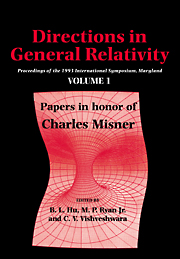 Directions in General Relativity
Directions in General Relativity Published online by Cambridge University Press: 03 February 2010
Abstract
We extend the argument that spacetimes generated by two timelike particles in D=3 gravity (or equivalently by parallel-moving cosmic strings in D=4) permit closed timelike curves (CTC) only at the price of Misner identifications that correspond to unphysical boundary conditions at spatial infinity and to a tachyonic center of mass. Here we analyze geometries one or both of whose sources are lightlike. We make manifest both the presence of CTC at spatial infinity if they are present at all, and the tachyonic character of the system: As the total energy surpasses its tachyonic bound, CTC first begin to form at spatial infinity, then spread to the interior as the energy increases further. We then show that, in contrast, CTC are entirely forbidden in topologically massive gravity for geometries generated by lightlike sources.
Among the many fundamental contributions by Charlie Misner to general relativity is his study of pathologies of Einstein geometries, particularly NUT spaces, which in his words are “counterexamples to almost everything”; in particular they can possess closed timelike curves (CTC). As with other farsighted results of his which were only appreciated later, this 25-year old one finds a resonance in very recent studies of conditions under which CTC can appear in apparently physical settings, but in fact require unphysical boundary conditions engendered by identifications very similar to those he discovered. In this paper, dedicated to him on his 60th birthday, we review and extend some of this current work. We hope it brings back pleasant memories.
Introduction
Originally constructed by Gödel [1], but foreshadowed much earlier [2], spacetimes possessing CTC in general relativity came as a surprise to relativists.
To save this book to your Kindle, first ensure no-reply@cambridge.org is added to your Approved Personal Document E-mail List under your Personal Document Settings on the Manage Your Content and Devices page of your Amazon account. Then enter the ‘name’ part of your Kindle email address below. Find out more about saving to your Kindle.
Note you can select to save to either the @free.kindle.com or @kindle.com variations. ‘@free.kindle.com’ emails are free but can only be saved to your device when it is connected to wi-fi. ‘@kindle.com’ emails can be delivered even when you are not connected to wi-fi, but note that service fees apply.
Find out more about the Kindle Personal Document Service.
To save content items to your account, please confirm that you agree to abide by our usage policies. If this is the first time you use this feature, you will be asked to authorise Cambridge Core to connect with your account. Find out more about saving content to Dropbox.
To save content items to your account, please confirm that you agree to abide by our usage policies. If this is the first time you use this feature, you will be asked to authorise Cambridge Core to connect with your account. Find out more about saving content to Google Drive.